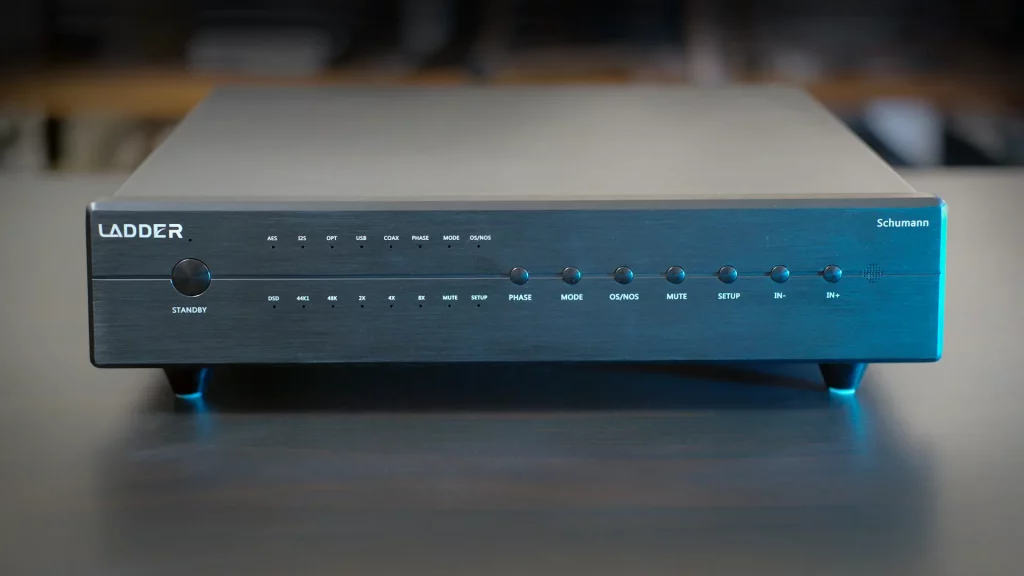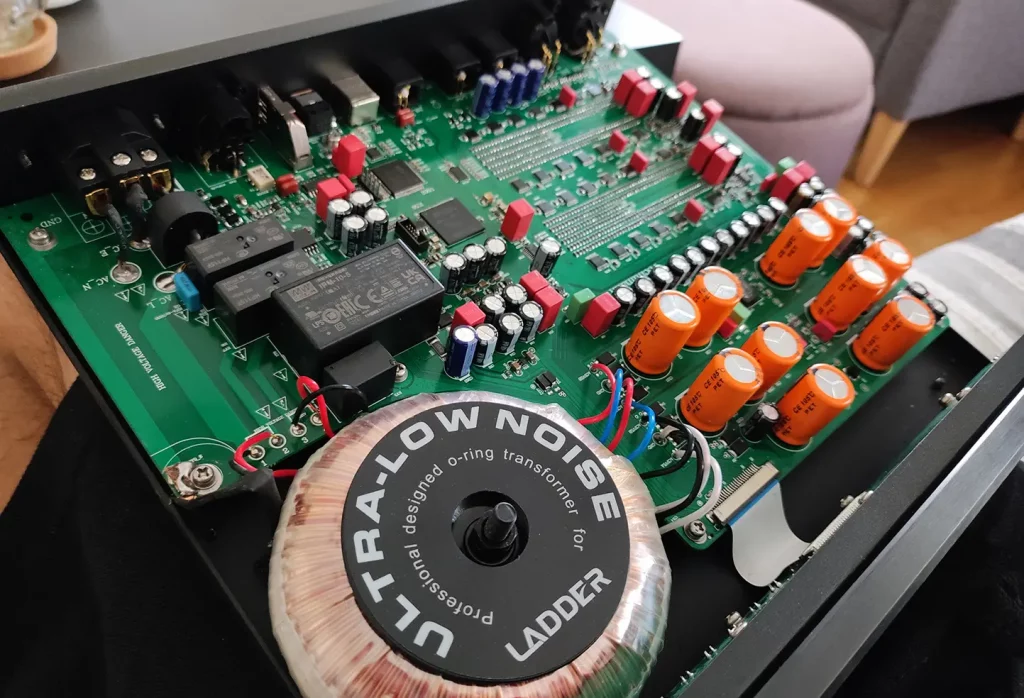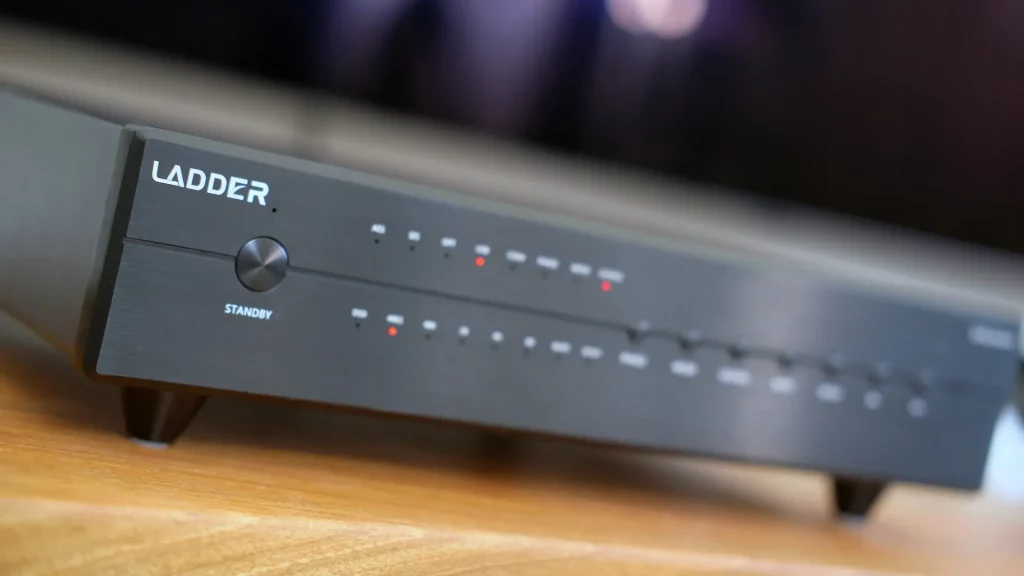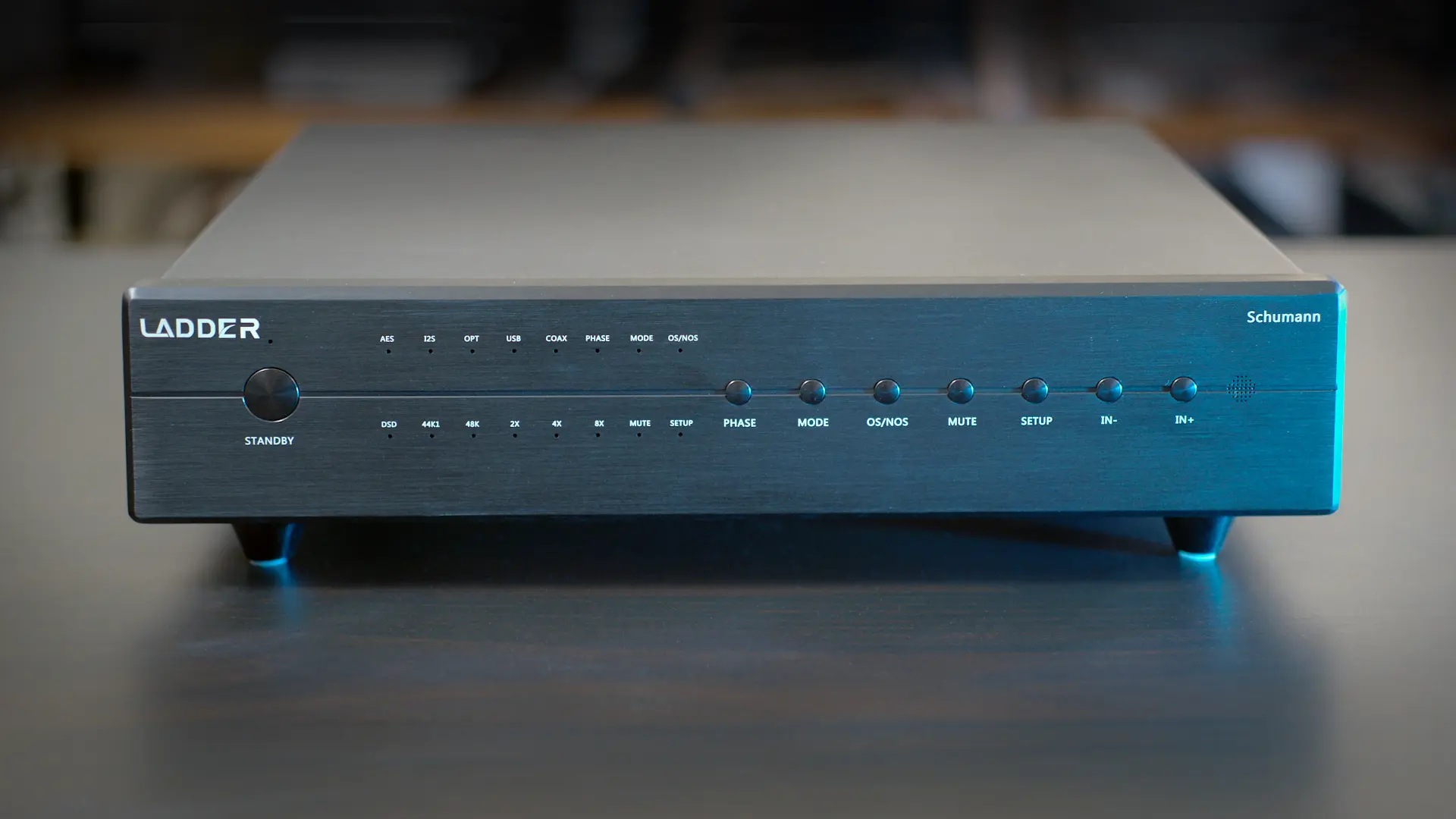I was contacted by ShenzhenAudio to review Ladder Schumann, the first DAC of a newly established brand Ladder. It didn’t take me long to browse through its features to answer that I’m in. A few weeks later, a DHL courier brought a big box to my doorstep. Opening this one was not a glamorous experience. No branding on it, no pamphlets inside, no extra goodies in any shape or form… Just a well-packed and well-protected DAC and a power cord. This better sound really good – I thought to myself.
Build and Connectivity
Ladder Schumann is a moderately sized DAC made out of metal entirely. A thick aluminium plate sits on the front, filled with an array of buttons and two arrays of small red LEDs. Commands are basically self-explanatory but the important thing to notice is that there is no remote control, so you’ll have to stand up, if you need to change your input for example, and do it manually. Everything aside that thick front panel is made of thinner metal sheets. The construction of the whole device feels good and sturdy nonetheless, and considerable weight only adds to that impression.
In the back, you’ll find basically every digital input there is: USB, optical, coaxial, AES/EBU, and I2S. The last one is done over HDMI port and the pinout is not configurable so making it work with your particular digital source will be a game of chances. HiFi brands really need to standardize this protocol soon if we’re going to use it without a hassle, but today is not that day. As for the analog side of things, we can see both single-ended RCA outs and balanced XLRs. Lastly, this unit is powered directly from the mains and the gelded IEC power inlet comes from the reputable Furutech brand. This might not mean much to you if you’re new to this hobby but it certainly tells something about the overall care that went into creating this DAC.


Tech and Features
Ladder Schumann is an R2R DAC using FPGA circuitry for signal decoding. A linear power supply with a chunky toroidal transformer and a bank of capacitors is used. Schumann supports hi-resolution PCM formats up to 384 kHz and up to DSD512. The more interesting thing to mention is that PCM can be listened to in both OS and NOS modes (Oversampling and Non-oversampling). OS mode is also available in two flavors: Fast or Slow roll-off. Now using these options will come naturally to anyone who has previous experience with Denafrips DACs because Ladder shares the same layout and controls. This is fortunate because my unit came without even the simplest of user manuals, which I thought happened due to the nature of my early review unit.
So as you can see, Schumann is not brimming with features and functions. There is no volume control, remote, or display. It is a spartan DAC for sure, but a really well-built and well-designed one as my further testing and listening will show.

Sound
After being connected to your system for the first time, Ladder Schumann will need some time to warm up before sounding its best. Before the optimum temperature is reached sound might appear flat and congested, at least compared to what it will be like once it reaches its best. Once that’s out of the way we can talk about its talents and make no mistake this is one talented device.
To start with something that all R2R DACs do right, tone timbre is absolutely great. All the way from the bass to the highs, there is a sense of fullness and richness to the tone that is simply not granted with every DAC at this price level – or any price level for that matter. Every instrument and every vocal, male or female, sounds very present in space and full-bodied. The meat on those musical bones makes everything played through this DAC feel palpable. Bassline is deep and bold, there’s a pleasant warmth to it that never feels overbearing. Moving to the midrange, we’re talking about a very rich, natural, but ever so slightly warm presentation that just feels right in this case. Highs are well extended, detailed, and informative, but very smooth and without a hint of digital glare or sharpness.
But what about those things that are not given with R2Rs, meaning speed, resolution, and detail retrieval? Well, even though it’s not on the level of the most revealing Delta Sigma DACs on the market, Schumann is a very capable DAC in those regards too. Transients are not really fast, but I wouldn’t call them sluggish either. Schumann is not a kung-fu fast but instead feels more like a very nimble heavy-weight boxer. On the other hand, inner tone details and textures are beautifully revealed in a way that would make most DS DACs sound simplistic and flat.
Soundstaging is once again something R2Rs do best and this one is no exception. The soundstage goes wide and deep, deeper than with any DS DAC but not as deep as with the best R2Rs on the market. That’s OK because in its respectable scene size, Schumman layers and separates masterfully. Each instrument has its own space, it’s rooted to its position firmly, and feels three-dimensional. Jazz and chamber music or anything with naturally recorded instruments will simply come alive inside your room. Make no mistake, this DAC is not choosy about the music genres and will happily make you hum along with your favorite Rock, Pop, Jazz, Blues, and other songs. The only situation I’d recommend something else would be if you’re mostly into fast-paced electronic music.

Comparisons
Ladder Schumman made such a good impression that I wanted to compare it to the best DACs I had with me at the moment.
Topping D90LE is a really good and neutral-sounding Delta Sigma DAC. However, in direct comparison to Schumann, D90LE simply appeared flat and lifeless. Yes, it is quicker and it shoots transients like there’s no tomorrow but that’s about the only win it could take. Schumann sounds much more spacious and more threedimensional, with fuller tone timbre and richer tone texture. To put it simply – Schumann just makes music come alive in your room the way that D90LE can’t. That said, the price difference is considerable and D90LE is richer with features so it is a good deal on its own, just not capable to compete with Schumann sound-wise.
Denafrips Ares II is an older and more affordable R2R that looks and feels very similar. Both have a huge soundstage too but that’s where similarities end. Ares II is the less resolving DAC, its bassline and midbass are more bloated, less defined, and not as punchy. The same is true for the upper frequencies too – less resolution and less dynamics. Tonally speaking, from the midrange upwards, Ares II takes on a brighter tonality and can sometimes feel a bit dry. Schumann sounds fuller and more natural in these upper registers while still revealing noticeably more information. All of this makes Schumann a much more capable DAC in my book. Looking at Denafrips, I guess that Pontus II would put a much better fight here, but I can’t do that comparison since I don’t have it.
Musician Pegasus is another DAC with a similar R2R design and this one put a much better fight than the previous two. Pegasus is a punchy-sounding DAC that can rival Schumann with bass response. It can also unveil similar amounts of details to Schumann across the frequency spectrum. While its soundstage is better than with most DS models, Pegasus can’t match the layering and three-dimensionality that Schumann brings to the table. It simply sounds a bit flatter and Ladder drives a win here by sounding lusher and recreating all instruments and vocals in a more life-like way.
Conclusion
Ladder might be a new brand label on the market, but people that worked on this DAC and designed it sure knew what they were doing. Schumann is one of the finest-sounding DACs that I’ve ever heard in my system. It sounds organic and brings music alive in such a way that makes you forget about all the shiny features and paper-wins that some other models might offer.
And while I have zero complaints about this fantastic product and its sound, the brand’s behavior did leave me wanting more. As far as I am aware, several months after my initial YouTube review, customers are still getting this unit without any sort of user manual. Yes, this DAC is very simple when it comes to its functions but at least a small quick guide on how to switch OS modes would be appropriate at least. Until then, I will share with you what appears to be a short user-written manual that was kindly sent to me by Eugene C: Link. On the other hand, both Windows drivers and the latest firmware (that I haven’t tried and can’t say what it brings) can be found on the ShenzhenAudio download page.






Thanks Srboljub!
I only listen to classical music and only occasionally to old French “variety” music (Barbara, Brel, Aznavour etc…). I have only recently starting builiding a system since I recently retired. My first purchase was a pair of BMR Philharmonic Audio that I listened to at a frien’s place (their finish in rosewood is gorgeous too!). Str
Atarting at the other end of the chain, I am looking at DACs to handle my CD collection. I have decided that R2R DACs are likely to fit my ears sensibilities better than the purely digital one, at least from what I read.
I plan on given the Schuman a try as it has a lolt of the connectivity I would value and the price is what I had in mind.
My question to you is about amplifiers. Do I need a pre-amp and if so, what examples. The amp should handle 4 Ohm impedance and probably 100 WPC would be plenty.
Any thoughts?
Francis
Unfortunately Amazon buyers wrote that it ‘will break down after a while…
I am looking for r2r upgrade. I started with Pegasus and bought the Gustard r2r.
I think your review on this DAC is what I feel I get with the Gustard.